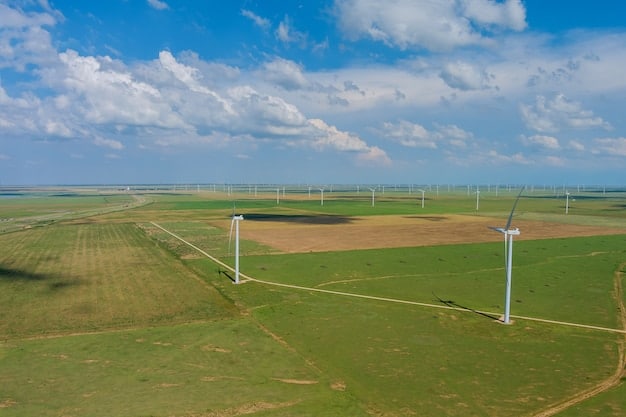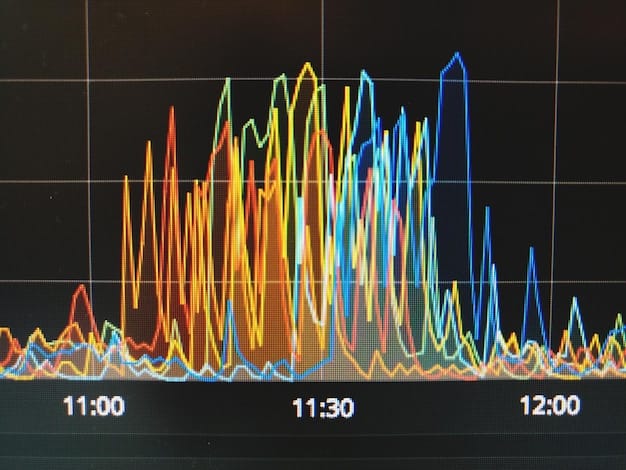Climate Change Report: Is the US on Track for 2030 Goals?

A recent climate change report evaluates the United States’ progress toward its 2030 emissions reduction goals, examining policy implementations, technological advancements, and economic factors influencing the nation’s ability to meet its commitments under the Paris Agreement.
The urgency surrounding climate change demands immediate action, and the United States has set ambitious goals to reduce emissions by 2030. But, according to the latest Climate Change Report: Is the US on Track to Meet Its 2030 Emissions Reduction Goals?, recent developments raise questions about whether the nation can truly achieve these targets.
Understanding the US Climate Change Commitments
The United States has pledged to significantly reduce its greenhouse gas emissions by 2030, aligning with the Paris Agreement. These commitments involve transitioning to cleaner energy sources, enhancing energy efficiency, and implementing policies to curb pollution. However, the path to achieving these targets is fraught with challenges.
The Paris Agreement and US Goals
The Paris Agreement, a landmark international accord, aims to limit global warming to well below 2 degrees Celsius above pre-industrial levels, and preferably to 1.5 degrees Celsius. The US initially committed to reducing emissions by 26-28% below 2005 levels by 2025, and more recently updated its pledge to a 50-52% reduction by 2030. These goals necessitate a fundamental shift in the nation’s energy infrastructure and industrial practices.

Key Sectors for Emissions Reduction
Several sectors contribute significantly to US greenhouse gas emissions, including electricity generation, transportation, industry, agriculture, and buildings. Addressing emissions from each sector requires tailored strategies and policies. For instance, transitioning to renewable energy sources like solar and wind is crucial for the electricity sector, while promoting electric vehicles and improving public transportation can reduce emissions from transportation.
- Electricity Generation: Phasing out coal-fired power plants and investing in renewable energy.
- Transportation: Increasing electric vehicle adoption and improving fuel efficiency standards.
- Industry: Implementing cleaner production processes and reducing methane leaks.
- Buildings: Enhancing energy efficiency through insulation and smart building technologies.
Successfully reducing emissions across these diverse sectors requires a combination of government policies, technological innovation, and behavioral changes. A failure in any one area could jeopardize the nation’s ability to meet its 2030 commitments.
In conclusion, the US climate change commitments are ambitious and demand a multifaceted approach. Understanding these commitments and the key sectors involved is crucial for assessing the nation’s progress and identifying areas that require greater attention.
Recent Progress in Emissions Reduction
Despite the challenges, the United States has made some progress in reducing its greenhouse gas emissions in recent years. This progress is attributable to a combination of factors, including the decline in coal consumption, the growth of renewable energy, and the implementation of various climate policies. However, the pace of emissions reduction needs to accelerate significantly to meet the 2030 targets.
Decline in Coal Consumption
One of the most significant factors contributing to emissions reduction has been the decline in coal consumption for electricity generation. Coal, the most carbon-intensive fossil fuel, has been steadily replaced by cleaner alternatives like natural gas and renewable energy. This transition has been driven by a combination of market forces, technological advancements, and environmental regulations.
Growth of Renewable Energy
The growth of renewable energy sources, particularly solar and wind, has played a crucial role in reducing emissions. Renewable energy has become increasingly cost-competitive with fossil fuels, making it an attractive option for utilities and consumers alike. Government policies, such as tax credits and renewable portfolio standards, have further incentivized the development of renewable energy projects. As renewable energy capacity continues to expand, its contribution to emissions reduction will become even more significant.
- Solar Energy: Rapidly declining costs and increasing efficiency have made solar energy a viable option.
- Wind Energy: Wind power has become a major source of electricity generation, particularly in the Midwest.
- Hydropower: Hydropower remains a significant source of renewable energy, but its growth potential is limited.
- Geothermal Energy: Geothermal energy offers a stable and reliable source of renewable power.
While the progress in emissions reduction is encouraging, it is important to recognize that the United States is not yet on track to meet its 2030 targets. The rate of emissions reduction needs to accelerate significantly in the coming years to bridge the gap.
In summary, the progress in emissions reduction reflects positive trends, but significant acceleration is needed. Sustaining and amplifying these efforts will be essential for achieving the ambitious climate goals set for 2030.
Policy and Regulatory Landscape
Government policies and regulations play a pivotal role in shaping the emissions trajectory of the country. Effective policies can accelerate the transition to a low-carbon economy, while weak or inconsistent policies can hinder progress. A comprehensive and coordinated policy approach is essential for achieving the 2030 emissions reduction targets.
Federal Climate Policies
At the federal level, several key climate policies are in place, including the Clean Power Plan (although its future remains uncertain), tax credits for renewable energy, and fuel efficiency standards for vehicles. The Inflation Reduction Act, passed in 2022, represents a significant investment in clean energy and climate solutions.
State and Local Initiatives
Many states and local governments have taken the lead in implementing climate policies. California, for example, has established a cap-and-trade program and ambitious renewable energy targets. Cities across the country are implementing energy efficiency programs and investing in public transportation. These subnational initiatives can serve as models for federal action and contribute significantly to overall emissions reduction efforts.

Challenges and Opportunities
Despite the progress made in implementing climate policies, several challenges remain. One major challenge is the political opposition to climate action, particularly from certain segments of the fossil fuel industry. Overcoming this opposition requires building broad-based support for climate solutions and effectively communicating the economic benefits of a low-carbon economy. Additionally, ensuring that climate policies are equitable and do not disproportionately burden low-income communities is essential.
- Political Opposition: Overcoming resistance to climate action.
- Policy Implementation: Ensuring effective implementation of climate policies.
- Economic Competitiveness: Maintaining economic competitiveness in a low-carbon world.
- Environmental Justice: Addressing the disproportionate impacts of climate change on vulnerable communities.
The political and regulatory landscape surrounding climate change is complex, but a strong commitment to effective policies can unlock potential. Addressing challenges ensures a path towards meeting the 2030 emissions reduction goals.
In summary, the policy and regulatory landscape forms the backbone of climate action. Navigating this complexity with foresight and determination will pave the way for achieving the ambitious 2030 targets.
Technological Innovations Driving Change
Technological innovation is a critical driver of emissions reduction, offering new and more efficient ways to generate energy, transport goods, and manufacture products. Investing in research and development and deploying these technologies at scale is essential for achieving the 2030 targets.
Renewable Energy Technologies
Advancements in renewable energy technologies, such as solar photovoltaics, wind turbines, and energy storage systems, are driving down costs and increasing efficiency. These technologies are becoming increasingly competitive with fossil fuels, making them a viable option for meeting the growing demand for electricity. Further innovation in these areas can accelerate the transition to a clean energy economy.
Carbon Capture and Storage
Carbon capture and storage (CCS) technologies offer the potential to capture carbon dioxide emissions from industrial facilities and power plants and store them underground. While CCS technologies are still under development, they could play a significant role in reducing emissions from hard-to-abate sectors, such as cement and steel production. Further research and development are needed to reduce the costs and improve the efficiency of CCS technologies.
Energy Efficiency Technologies
Energy efficiency technologies, such as LED lighting, smart thermostats, and advanced insulation materials, can significantly reduce energy consumption in buildings and industries. Investing in energy efficiency measures is often the most cost-effective way to reduce emissions. Government policies, such as building codes and appliance standards, can further promote the adoption of energy efficiency technologies.
Innovation across renewable energy, carbon capture, and energy efficiency technologies is key to emissions reduction, demanding continuous progress and deployment.
In conclusion, technological innovations are crucial for surpassing the 2030 targets. Maintaining a focus on research, development, and deployment will guarantee progress in building a sustainable, low-carbon future.
Economic Factors Influencing Progress
Economic factors play a key role in influencing the progress of emissions reduction efforts including the cost competitiveness of renewable energy, the availability of financing for clean energy projects, and the economic impacts of climate policies. Understanding these economic dynamics is essential for designing effective climate strategies.
Cost Competitiveness of Renewable Energy
The declining costs of renewable energy technologies have been a major driver of emissions reduction. As renewable energy becomes more cost-competitive with fossil fuels, it becomes an increasingly attractive option for utilities and consumers. Government policies, such as tax credits and subsidies, can further enhance the cost competitiveness of renewable energy.
Financing for Clean Energy Projects
The availability of financing for clean energy projects is crucial for accelerating the transition to a low-carbon economy. Private investors, banks, and government agencies all have a role to play in providing financing for renewable energy projects, energy efficiency upgrades, and other climate-related investments. Addressing barriers to financing, such as high transaction costs and perceived risks, is essential for unlocking the full potential of clean energy.
Economic Impacts of Climate Policies
The economic impacts of climate policies are a subject of ongoing debate. Some argue that climate policies will harm economic growth, while others contend that they can create new jobs and stimulate innovation. Carefully designed climate policies can minimize negative economic impacts and maximize co-benefits, such as improved air quality and energy security.
- Job Creation: Promoting green jobs in renewable energy and energy efficiency sectors.
- Economic Growth: Stimulating innovation and investment in clean technologies.
- Energy Security: Reducing dependence on fossil fuel imports.
- Public Health: Improving air quality and reducing health costs.
Economic forces, including cost, funding, and effects from policies, impact climate change progress, making it imperative to understand and optimize these elements.
In summary, economic factors are central to influencing emissions reduction success. Analyzing, addressing, and leveraging these factors strategically sets the stage for reaching the 2030 goals.
Potential Setbacks and Challenges Ahead
Despite the progress made and the opportunities ahead, several potential setbacks and challenges could hinder the US from meeting its 2030 emissions reduction goals. These include policy reversals, technological hurdles, and economic uncertainties. Addressing these challenges proactively is essential for staying on track.
Policy Reversals
Changes in political leadership can lead to reversals in climate policies, undermining progress made under previous administrations. For example, the Trump administration withdrew the US from the Paris Agreement and rolled back several environmental regulations. Sustaining long-term emissions reduction efforts requires durable policies that are resistant to political shifts.
Technological Hurdles
While many promising clean energy technologies are under development, some may not be ready for widespread deployment by 2030. For example, carbon capture and storage technologies are still relatively expensive and energy-intensive. Overcoming these technological hurdles requires sustained investment in research and development and policy support for early-stage technologies.
Economic Uncertainties
Economic downturns, trade disputes, and other economic shocks can disrupt clean energy investments and slow down emissions reduction efforts. For example, the COVID-19 pandemic caused a sharp decline in economic activity, which led to a temporary reduction in emissions. However, as the economy recovered, emissions rebounded. Building resilience into climate strategies is essential for mitigating the impacts of economic uncertainties.
Policy changes, tech obstacles, and economic instabilities present significant challenges that could set back US emissions reduction goals, necessitating preparedness and resilience.
In conclusion, it is very important to identify and tackle possible hindrances to stay on track for reaching the 2030 goals. Building flexibility, fostering sustained support for climate action, and resolving technological difficulties are fundamental for overcoming obstacles.
| Key Point | Brief Description |
|---|---|
| 🌱 US Climate Goals | Aims for 50-52% emissions cut by 2030, aligning with the Paris Agreement. |
| ⚡ Renewable Growth | Solar and wind energy rapidly expanding, boosting emissions reduction efforts. |
| 🏛️ Policy Impact | Government policies are key, influencing the transition to low-carbon economy. |
| 💡 Tech Innovation | Tech advancements offer more efficient energy and transport, crucial to reach targets. |
FAQ
▼
The US aims to reduce greenhouse gas emissions by 50-52% below 2005 levels by 2030, aligning with the Paris Agreement goals for a more sustainable future.
▼
Critical sectors include electricity generation, transportation, industry, and buildings. Addressing each sector with tailored strategies and innovative technologies strengthens overall efforts.
▼
Renewable energy, especially solar and wind, is rapidly expanding due to decreasing costs and greater efficiency, significantly lowering dependence on fossil fuels and emissions.
▼
Changes in political leadership can cause policy reversals, affecting regulatory certainty, investments, and the continuity of emissions reduction efforts and climate action.
▼
Technological innovations, such as CCS and energy efficiency solutions enhance energy production and lower energy usage, critical for lowering overall emissions and helping meet climate goals.
Conclusion
In conclusion, whilst the United States has indeed demonstrated notable progress towards its ambitious climate goals set for 2030 in the Climate Change Report, meeting these targets is far from assured. The interplay of policy, economic factors, and technological advancements necessitates unwavering dedication and strategic evolution. Navigating these complex dynamics effectively will define the success of achieving substantial emissions reductions and fostering a sustainable, resilient future for the nation.





